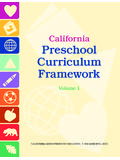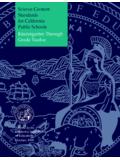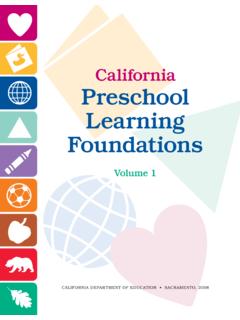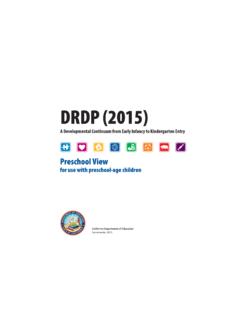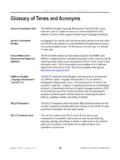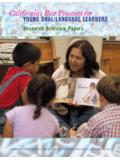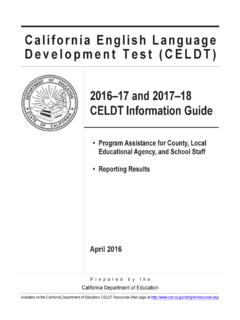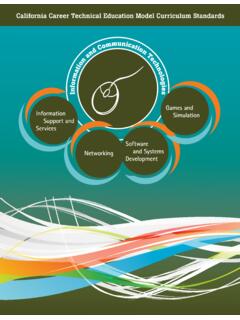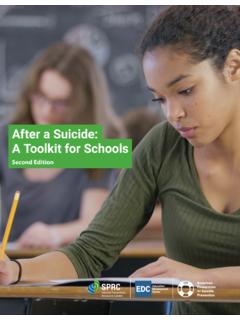Transcription of California Dyslexia Guidelines - California Department of ...
1 CaliforniaDyslexiaGuidelinesCalifornia Department of EducationSacramento, 2017(Last Modified October 2017)This page intentionally left Department of EducationSacramento, 2017(Last Modified October 2017)Publishing Information California Dyslexia Guidelines was prepared under the direction of the Special Education Division of the California Department of Education (CDE). This publication was edited by John McLean, working in cooperation with Allison Smith, Special Education Consultant, Policy and Program Services Unit, CDE Special Education Division. The document was prepared for publication by the staff of CDE Press; Aristotle Ramirez created the cover and interior design. It was published by the Department of Education, 1430 N Street, Sacramento, CA 95814, and was distributed under the provisions of the Library Distribution Act and Government Code Section 11096. 2017 by the California Department of Education All rights reserved ISBN: 978-0-8011-1783-1 Notice The guidance in California Dyslexia Guidelines is not binding on local educational agencies or other entities.
2 Except for the statutes, regulations, and court decisions that are referenced herein, the document is exemplary, and compliance with it is not mandatory. (See Education Code Section ) Additional Publications and Educational Resources For information about publications and educational resources available from the California Department of Education, please visit the CDE s Educational Resources Catalog page or call the CDE Press sales office at 1-800-995-4099. Contents A Message from the State Superintendent of Public Instruction .. v Introduction .. 1 Chapter 1: A Twenty-First-Century Definition of Chapter 2: The Neuroscience of Dyslexia ..6 Chapter 3: Dyslexia as a Language-Learning Disability ..9 Chapter 4: Characteristics of Dyslexia by Age Group Strengths and Weaknesses ..14 Chapter 5: Socioemotional Factors of Dyslexia .. 24 Chapter 6: When the Concern May Not Be Chapter 7: Dyslexia in English Learners .. 33 Chapter 8: Pre-Service and In-Service Preparation for Educators.
3 38 Chapter 9: Screening and Assessment for Dyslexia .. 42 Chapter 10: Special Education and 504 Plans .. 59 Chapter 11: Effective Approaches for Teaching Students with 63 Chapter 12: Assistive Technology .. 75 Chapter 13: Information for Parents and Guardians ..81 Chapter 14: Frequently Asked Questions .. 95 Appendix A: Assessment Tools ..99 Appendix B: Assistive Technology Resources ..103 Appendix C: Legal Glossary ..106 110 This page intentionally left blank. A MESSAGE FROM THE State Superintendent of Public Instruction I am pleased to present California Dyslexia Guidelines , which was written in response to the passage of Assembly Bill 1369, Chapter 647, Statutes of 2015, and which added sections 56334 and 56335 to California s Education Code. The purpose of these Guidelines is to assist regular education teachers, special education teachers, and parents in identifying, assessing, and supporting students with Dyslexia . The work of the California Department of Education was accomplished with the invaluable contributions of a broad range of stakeholders who provided their expertise in the many topic areas addressed in the Guidelines .
4 These Guidelines draw on both current research and the collective professional wisdom and experience of the members of the Dyslexia Guidelines Work Group, which met in a series of seven meetings from April 2016 through March 2017. The ability to read is a fundamental skill in modern society. It is the foundation on which we can build lifelong learning. When we learn to read, we are liberated: the entirety of the world s knowledge is available to us, and we are empowered to take control of our own education. Yet for people with Dyslexia , this ability can be frustratingly out of reach. They struggle to master the code that translates groups of letters into meaningful words, sentences, passages, and books. Over the past several decades, we have learned a great deal about Dyslexia . For example, we have learned that Dyslexia is a real disability that is neurobiological in nature and affects millions of people around the world. We have also learned that for most people with Dyslexia , the primary problem is difficulty in being able to recognize and manipulate the smallest units of sounds, called phonemes, in human language.
5 This makes it difficult to link these sounds to the letter or letters, called graphemes, that represent the sounds in print. Difficulty making the connections between sounds and letters leads to problems with reading words, sentences, and passages fluently. We have learned how to identify people with Dyslexia at a very early age and later in life. And we have learned that early identification and intervention is very important. We have also learned how to teach people with Dyslexia to read fluently and with comprehension. Extensive research has shown us that reading instruction for students with California Dyslexia Guidelines | v Dyslexia must teach phonemic awareness the ability to recognize and manipulate phonemes in words. Students must be taught how to link these phonemes to letters and how to blend sounds and segment words when reading and spelling a method of teaching early reading known as phonics. This reading instruction must also teach vocabulary, fluency, and reading comprehension strategies.
6 Additionally, we have learned that effective reading programs for students with Dyslexia incorporate multisensory techniques to explicitly and systematically teach all of the skills mentioned above, so that each new skill builds logically and coherently on the skills that were taught before. Perhaps most importantly, we have learned that there is hope for people with Dyslexia but to translate that hope into reality takes a concerted and relentless effort. The purpose of California s Dyslexia Guidelines is to provide educators, parents, and other stakeholders with a road map for supporting students with Dyslexia in California s public schools. Tom Torlakson State Superintendent of Public Instruction vi | California Dyslexia Guidelines Acknowledgments The development of California s Dyslexia Guidelines involved the many people who participated in the Dyslexia Guidelines Work Group from 2016 to 2017. The California Department of Education extends its profound gratitude to the following individuals and the organizations they represented for their generous contributions of time and expertise in writing these Guidelines .
7 Michele Andrus, Advisory Commission on Special Education Amy Balmanno, California Association of school Psychologists Joyce Childs, CARS+ Organization for Special Educators Joe Comiskey, Special Education Administrators of County Offices Laura Anne Denton, Diagnostic Center, Northern California , California Department of Education Kathy Futterman, California State University, East Bay Victoria Graf, Loyola marymount University Fumiko Hoeft, University of California , San Francisco, and the International Dyslexia Association Brian Inglesby, Special Education Local Plan Area Directors Virginia Kennedy, California State University, Northridge Roberta Kreitz, California Teachers Association Tobie Meyer, Decoding Dyslexia California Danielle Nahas, San Diego Unified school District, Bilingual Support Network Anjanette Pelletier, Association of California school Administrators Sally Shaywitz, Yale University Sarah Solari, California Commission on Teacher Credentialing Leah Sugarman, California Federation of Teachers Jan Tuber, Parents Helping Parents Richard Wagner, Florida State University Jeannene Ward-Lonergan, California Speech-Language-Hearing Association Nancy C ushen White, International Dyslexia Association Kristin Wright, State Board of Education California Dyslexia Guidelines | vii This page intentionally left blank.
8 Introduction Educating students with Dyslexia is a dynamic field of inquiry and practice; each year brings new discoveries about this condition. California s Dyslexia Guidelines represent a snapshot in time. They attempt to provide up-to-date information to parents, general educators, and special educators while building on hard-won knowledge confirmed over decades of research. Although the information provided in these Guidelines is not legally binding on local educational agencies, the goal in publishing California Dyslexia Guidelines is to create a document that provides practical resources for identifying and educating students who are struggling academically because they cannot read. This document is structured to present technical information in an accessible format by organizing text with introductory chapter bullets, brief paragraphs, graphic elements, and relatively short chapters. Entire books have been written on many of the areas covered by these Guidelines , so Web links to additional resources are provided at the conclusion of every chapter for readers who want to know more about specific topics.
9 The California Department of Education believes that the following principles are essential to educating students with Dyslexia . These principles form the foundation of the Guidelines and inform the perspective from which the Guidelines were written: Students with Dyslexia need a knowledge-based and active system of support thatincludes families, educators, and other professionals. Learning needs related to Dyslexia exist on a continuum; therefore, systems of supportmust be designed to meet the diversity of students needs. An educational system should address the needs of individual students within anintegrated and tiered system of support. Students who have Dyslexia are general education students first, can be educated ingeneral education classrooms, and benefit from a wide variety of supports. Those supportsmust include a comprehensive, evidence-based approach to reading and languageinstruction that is implemented by trained educators. Required supports may includevarious accommodations and assistive technology.
10 Students with Dyslexia sometimesrequire special education. An interdisciplinary team approach is most effective when it takes advantage of everyone s expertise and includes all team members in decision making, problem solving,and instructional Dyslexia Guidelines | 1 Guiding principles for educating students with Dyslexia must be anchored in programsthat are evidence based, whenever possible, and that incorporate structured literacy instruction that is comprehensive, systematic, explicit, cumulative, and these principles in mind, and the content provided in the following chapters, California s Dyslexia Guidelines seek to improve the academic outcomes for all students with Dyslexia in all education settings. 2 | California Dyslexia Guidelines CHAPTER 1 A Twenty-First-Century Definition of Dyslexia This chapter covers the following topics: The InternationalDyslexia Association sdefinition of Dyslexia The definition of Dyslexia as a specificlearning disability The most currentdescription of Dyslexia accordingto a SenateResolution passed in 2016 Online sources for more informationThe International Dyslexia Association (IDA) provides the following definition of Dyslexia , which was adopted by the United States National Institutes of Child Health and Human Development (Lyon, Shaywitz, and Shaywitz 2003).
